United States Census
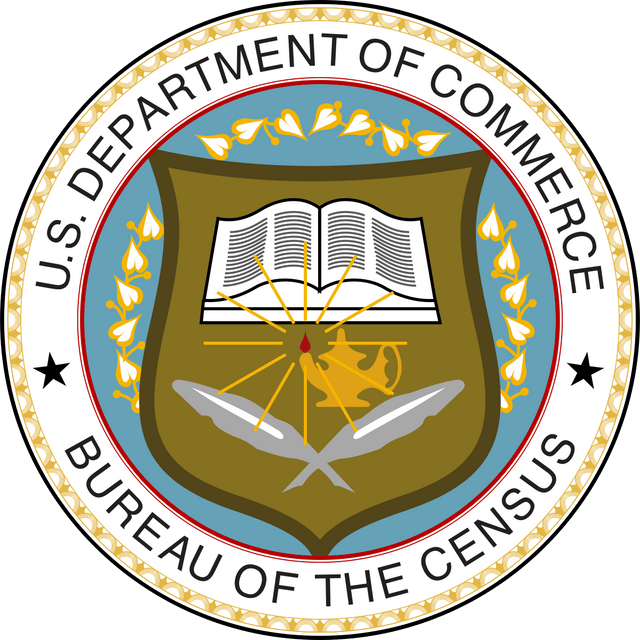
United States Census

| United States Census | |
|---|---|
| Frequency | Decennial |
| Location(s) | 4600 Silver Hill Rd.Suitland],Maryland20746 |
| Country | United States |
| Inaugurated | August 2, 1790 |
| Most recent | April 1, 2010 |
| Next event | 2020 |
| Website | |
The United States Census (plural censuses or censi) is a decennial census mandated by Article I, Section 2 of the United States Constitution, which states: “Representatives and direct Taxes shall be apportioned among the several States... according to their respective Numbers.... The actual Enumeration shall be made within three years after the first meeting of the Congress of the United States, and within every subsequent Term of ten Years”.[3][32] Section 2 of the 14th Amendment amended Article I, Section 2 to include that the "respective Numbers" of the "several States" will be determined by "counting the whole number of persons in each State... excluding Indians not taxed...” The United States Census Bureau (officially the Bureau of the Census, as defined in Title 13 U.S.C. § 11) is responsible for the United States Census. The Bureau of the Census is part of the United States Department of Commerce.
The first census after the American Revolution was taken in 1790, under Secretary of State Thomas Jefferson; there have been 22 federal censuses since that time.[32]
The current national census was held in 2010; the next census is scheduled for 2020. Starting in 2013, the Census Bureau began discussions on using technology to aid data collection starting with the 2020 Census[33]. In 2020, every household will receive an invitation to complete the census over the internet, by phone or by paper questionnaire.[34][35] For years between the decennial censuses, the Census Bureau issues estimates made using surveys and statistical models, in particular, the Population Estimates Program and American Community Survey.
Title 13 of the United States Code governs how the Census is conducted and how its data is handled. Information is confidential as per 13 U.S.C. § 9 [89]. The census law, coupled with the Sentencing Reform Act of 1984 (Title 18 of the United States Code, Sections 3551, 3559, and 3571), provides for penalties of up to $5,000 for not responding or for willfully providing false answers to any question.
The United States Census is a population census, which is distinct from the U.S. Census of Agriculture, which is no longer the responsibility of the Census Bureau. It is also distinct from local censuses conducted by some states or local jurisdictions.
| United States Census | |
|---|---|
| Frequency | Decennial |
| Location(s) | 4600 Silver Hill Rd.Suitland],Maryland20746 |
| Country | United States |
| Inaugurated | August 2, 1790 |
| Most recent | April 1, 2010 |
| Next event | 2020 |
| Website | |
Procedure
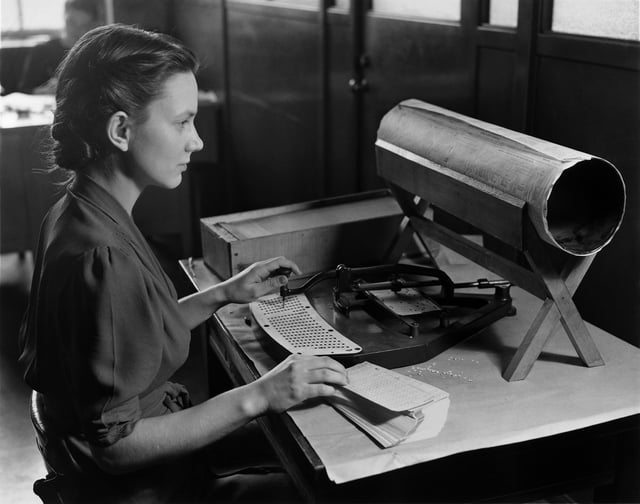
A woman with a Hollerith pantograph punch, the keyboard is for the 1920 US Census population card
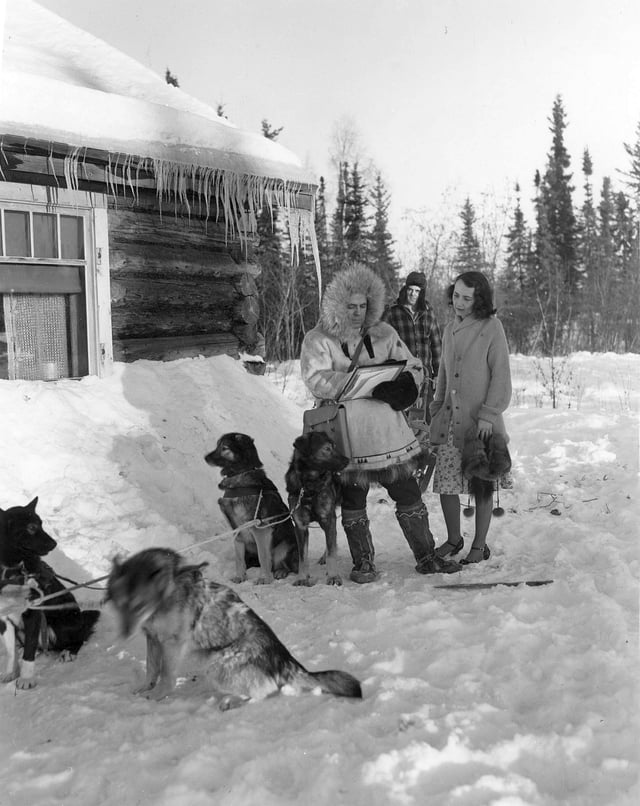
This 1940 Census publicity photo shows a census worker in Fairbanks, Alaska. The dog musher remains out of earshot to maintain confidentiality.
Decennial U.S.
Census figures are based on actual counts of persons dwelling in U.S. residential structures.
They include citizens, non-citizen legal residents, non-citizen long-term visitors and undocumented immigrants.
The Census Bureau bases its decision about whom to count on the concept of usual residence.
Usual residence, a principle established by the Census Act of 1790, is defined as the place a person lives and sleeps most of the time.
The Census Bureau uses special procedures to ensure that those without conventional housing are counted; however, data from these operations are not considered to be as accurate as data obtained from traditional procedures.[36]
The Census also uses hot-deck imputation to assign data to housing units where occupation status is unknown. This practice has effects across many areas, but is seen by some as controversial.[37] However, the practice was ruled constitutional by the U.S. Supreme Court in Utah v. Evans
Certain American citizens living overseas are specifically excluded from being counted in the census even though they may vote.
Only Americans living abroad who are “Federal employees (military and civilian) and their dependents living overseas with them” are counted.
“Private U.S. citizens living abroad who are not affiliated with the Federal government (either as employees or their dependents) will not be included in the overseas counts.
These overseas counts are used solely for reapportioning seats in the U. S. House of Representatives”.[38]
According to the Census Bureau, “Census Day” has been April 1 since 1930.
Previously, from 1790 to 1820, the census counted the population as of the first Monday in August.
It moved to June in 1830, (June 2 in 1890), April 15 in 1910, and January 1 in 1920.[39]
Controversy
The Census Bureau estimates that in 1970 over six percent of African Americans went uncounted, whereas only around two percent of European Americans[40] went uncounted.
Democrats often argue that modern sampling techniques should be used so that more accurate and complete data can be inferred.
Republicans often argue against such sampling techniques, stating the U.S.
Constitution requires an “actual enumeration” for apportionment of House seats, and that political appointees would be tempted to manipulate the sampling formulas.[41]
Groups like the Prison Policy Initiative assert that the census practice of counting prisoners as residents of prisons, not their pre-incarceration addresses, leads to misleading information about racial demographics and population numbers.[42]
In 2010 Jaime Grant, then director of the National Gay and Lesbian Task Force's Policy Institute, thought of the idea of a bright pink sticker for people to stick on their census envelope which had a form for them to check a box for either “lesbian, gay, bisexual, transgender or straight ally,” which her group called “queering the census”.[43] Although the sticker was unofficial and the results were not added to the census, she and others hope the 2020 census will include such statistics.[43] In 2015 Laverne Cox called for transgender people to be counted in the census.[44]
On March 26, 2018 the U.S.
Dept of Commerce announced[45] plans to re-include a citizenship question in the 2020 census questionnaire which has not been included on the short form since 1950.[46] The Census Bureau distributed a “long form” to a sample of households receiving the standard Census form in three Censuses from 1970 to 2000[47], which included a question on citizenship.[48] The proposed citizenship question will be the same as the one that is asked on the yearly American Community Survey (ACS), which is answered by a sample of US households.[45][49]
Proponents of including the question claimed it is necessary to gather an accurate statistical count, while opponents claimed it might suppress responses to the Decennial Census and therefore lead to an inaccurate count.[50] Multiple states have sued the Trump administration arguing that the proposed citizenship question is unconstitutional and may intimidate illegal aliens and undocumented workers, resulting in inaccurate data on immigrant communities.[51] In January 2019 a federal judge in New York ruled against the proposal; the U.S. Government appealed that decision to the U.S. Supreme Court which heard oral arguments in April 2019 about whether the citizenship question was constitutional and whether the Secretary of Commerce followed the law when deciding to add the question, and will issue its decision by the end of the term in June or early July 2019.[52][53]
History
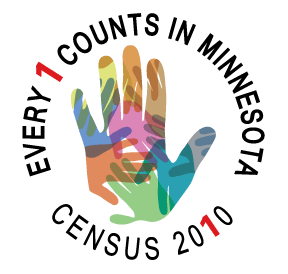
Census regional marketing logo in Minnesota.
Censuses had been taken prior to the Constitution's ratification; in the early 17th century, a census was taken in Virginia, and people were counted in nearly all of the British colonies that became the United States.
Throughout the years, the country's needs and interests became more complex.
This meant that statistics were needed to help people understand what was happening and have a basis for planning.
The content of the decennial census changed accordingly.
In 1810, the first inquiry on manufactures, quantity and value of products occurred; in 1840, inquiries on fisheries were added; and in 1850, the census included inquiries on social issues, such as taxation, churches, pauperism, and crime.
The censuses also spread geographically, to new states and territories added to the Union, as well as to other areas under U.S. sovereignty or jurisdiction.
There were so many more inquiries of all kinds in the census of 1880 that almost a full decade was needed to publish all the results.
In response to this, the census was mechanized in 1890, with tabulating machines made by Herman Hollerith. This reduced the processing time to two and a half years.[54]
For the first six censuses (1790–1840), enumerators recorded only the names of the heads of household and a general demographic accounting of the remaining members of the household.
Beginning in 1850, all members of the household were named on the census.
The first slave schedules were also completed in 1850, with the second (and last) in 1860.
Censuses of the late 19th century also included agricultural and industrial schedules to gauge the productivity of the nation's economy.
Mortality schedules (taken between 1850 and 1880) captured a snapshot of life spans and causes of death throughout the country.
The first nine censuses (1790–1870) were conducted by U.S.
Marshals before the Census Bureau was created.[55] Appointed US Marshals of each judicial district hired assistant marshals to conduct the actual enumeration.
The census enumerators were typically from the village or neighbourhood and often knew the residents.
Before enabling self-identification on the censuses, the US Census Bureau relied on local people to have some knowledge of residents.
Racial classification was made by the census enumerator in these decades, rather than by the individual.
| Year | Total population | Progress | Most populated state | Most populated city | Slaves | Notes |
|---|---|---|---|---|---|---|
| 1790[4] | 3,929,326[5] | — | Virginia(747,610) | New York],NY(33,131) | 694,280 | Original numbers were corrected later. |
| 1800[6] | 5,308,483[7] | Virginia][8](676,682) | New York],NY(60,515) | 893,605[9] | Original numbers were corrected later. | |
| 1810[10] | 7,239,881 | New York(959,049) | New York],NY(96,373) | 1,191,362 | — | |
| 1820[11] | 9,638,453 | New York(1,372,812) | New York],NY(123,706) | 1,538,022 | — | |
| 1830[12] | 12,866,020 | New York(1,918,608) | New York],NY(202,589) | 2,009,043 | — | |
| 1840[13] | 17,069,453 | New York(2,428,921) | New York],NY(312,710) | 2,487,355 | The census estimated thepopulation of the United Statesat 17,100,000.The results were tabulated by 28 clerks in the Bureau of the Census. | |
| 1850[14] | 23,191,876 | New York(3,097,394) | New York],NY(515,547) | 3,204,313 | The 1850 census was a landmark year in American census-taking.It was the first year in which the census bureau attempted to record every member of every household, including women, children and slaves.Accordingly, the first slave schedules were produced in 1850.Prior to 1850, census records had only recorded the name of the head of the household and tabulated the other household members within given age groups. | |
| 1860[15] | 31,443,321 | New York(3,880,735) | New York],NY(813,669) | 3,953,761 | The results were tabulated by 184 clerks in the Bureau of the Census.This was the first census where the American Indians officially were counted, but only those who had 'renounced tribal rules'.The figure for the nation was 40,000. | |
| 1870[16] | 39,818,449[17] | New York(4,382,759) | New York],NY(942,292) | — | The first census to provide detailed information on the black population, only years after the culmination of the Civil War when slaves were granted freedom.The results are controversial, as many believed it underestimated the true population numbers, especially in New York and Pennsylvania. | |
| 1880[18] | 50,189,209 | New York(5,082,871) | New York],NY(1,206,299) | The first census that permitted women to be enumerators.Also led to the discovery ofAlabama paradox. | ||
| 1890[19][1] | 62,947,714 | New York(6,003,174) | New York],NY(1,515,301) | Because it was believed that the frontier region of the United States no longer existed, the tracking of westward migration was not tabulated in the 1890 census.[56]This trend promptedFrederick Jackson Turnerto develop his milestoneFrontier Thesis.The1890 census was the first to be compiled using the newtabulating machinesinvented byHerman Hollerith.The net effect of the many changes from the 1880 census (the larger population, the number of data items to be collected, the Census Bureau headcount, the volume of scheduled publications, and the use of Hollerith's electromechanical tabulators) was to reduce the time required to fully process the census from eight years for the1880 censusto six years for the 1890 census.[57]The total population, of 62,947,714, was announced after only six weeks of processing (punched cards were not used for this family, orrough, count).[58][59]The public reaction to this tabulation was disbelief, as it was widely believed that the "right answer" was at least 75,000,000.[60]This census is also notable for the fact it is one of only three for which the original data are no longer available.Almost all the population schedules were destroyed following a fire in 1921. | ||
| 1900[20] | 76,212,168 | New York(7,268,894) | New York],NY(3,437,202) | — | ||
| 1910[21] | 92,228,496 | New York(9,113,614) | New York],NY(4,766,883) | — | ||
| 1920[22] | 106,021,537 | New York(10,385,227) | New York],NY(5,620,048) | This was the first census that recorded a population exceeding 100 million. | ||
| 1930[23][2] | 122,775,046 | New York(12,588,066) | New York],NY(6,930,446) | — | ||
| 1940[24] | 132,164,569 | New York(13,479,142) | New York],NY(7,454,995) | The most recent census where individuals' data have now been released to the public (by the72-year rule). | ||
| 1950[25] | 150,697,361 | New York(14,830,192) | New York],NY(7,891,957) | Will be available for public inspection on April 1, 2022. | ||
| 1960[26] | 179,323,175 | New York(16,827,000) | New York],NY(7,781,984) | Will be available for public inspection on April 1, 2032. | ||
| 1970[27] | 203,302,031 | California(19,953,134) | New York],NY(7,894,862) | The first census that recorded a population exceeding 200 million.Will be available for public inspection on April 1, 2042. | ||
| 1980[28] | 226,545,805 | California(23,667,902) | New York],NY(7,071,639) | Will be available for public inspection on April 1, 2052. | ||
| 1990[29] | 248,709,873 | California(29,760,021) | New York],NY(7,322,564) | Will be available for public inspection on April 1, 2062. | ||
| 2000[30] | 281,421,906 | California(33,871,648) | New York],NY(8,008,278) | Will be available for public inspection on April 1, 2072. | ||
| 2010[31] | 308,745,538 | California(37,253,956) | New York],NY(8,175,133) | The first short-form-only census since 1940, as the decennial long form has been replaced by theAmerican Community Survey.The first census that recorded a population exceeding 300 million.Will be available for public inspection on April 1, 2082. |
Respondent confidentiality
One purpose of the census is to divide the house seats by population.
Furthermore as with any Census Bureau survey the data provides a beginning for allocation of resources.
In addition, collected data are used in aggregate for statistical purposes.[61] Replies are obtained from individuals and establishments only to enable the compilation of such general statistics.
The confidentiality of these replies is very important.
By law, no one—neither the census takers nor any other Census Bureau employee—is permitted to reveal identifiable information about any person, household, or business.
By law (Pub.L. 95–416 [90], 92 Stat. 915 [91], enacted October 5, 1978), individual decennial census records are sealed for 72 years,[62] a number chosen in 1952[63] as slightly higher than the average female life expectancy, 71.6.[64] The individual census data most recently released to the public is the 1940 census, released on April 2, 2012. Aggregate census data are released when available.
Historical FBI use of data
Under the administration of President Franklin D. Roosevelt the Federal Bureau of Investigation (FBI), using primarily census records, compiled (1939–1941) the Custodial Detention Index ("CDI") on citizens, enemy aliens, and foreign nationals, who might be dangerous. The Second War Powers Act of 1941 repealed the legal protection of confidential census data, which was not restored until 1947. This information facilitated the internment of Japanese-Americans, following the Japanese attack on the U.S. at Pearl Harbor on December 7, 1941 and the internment of Italian- and German-Americans following the United States' entry into World War II.[65][66]
Data analysis
The census records data specific to individual respondents are not available to the public until 72 years after a given census was taken, but aggregate statistical data derived from the census are released as soon as they are available.
Every census up to and including 1940 is currently available to the public and can be viewed on microfilm released by the National Archives and Records Administration, the official keeper of archived federal census records. Complete online census records can be accessed for no cost from National Archives facilities and many libraries,[68] and a growing portion of the census is freely available from non-commercial online sources.[69][70][71]
Census microdata for research purposes are available for censuses from 1850 forward through the Integrated Public Use Microdata Series (IPUMS), and scanned copies of each of the decennial census questionnaires are available online from many websites. Computerized aggregate data describing the characteristics of small geographic areas for the entire period from 1790 to 2010 are available from the National Historical Geographic Information System.
Regions and divisions
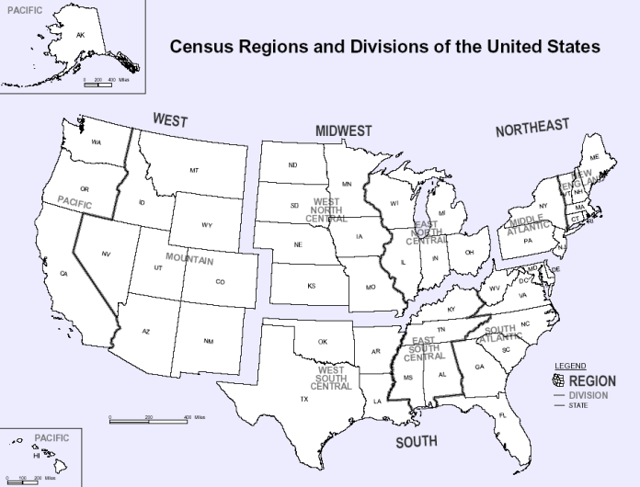
US Census Bureau Population Regions
The bureau recognizes four census regions within the United States and further organizes them into nine divisions. These regions are groupings of states that subdivide the United States for the presentation of data. They should not be construed as necessarily being thus grouped owing to any geographical, historical, or cultural bonds.
| US Census Regions | |||
|---|---|---|---|
| Region 1:Northeast | Region 2:Midwest | Region 3:South | Region 4:West |
|
|
|
|
See also
Census-designated place (CDP), a populated community that lacks a separate municipal government
Combined statistical area (CSA), an area that combines adjacent µSAs and MSAs
DUALabs
List of U.S. states by historical population, state-level US Census data, 1790–2010, in table form
State censuses in the United States of America
United States metropolitan area (MSA), an area that includes adjacent communities to major cities
United States micropolitan area (µSA), an urban area based around a core city or town with a population of 10,000 to 49,999